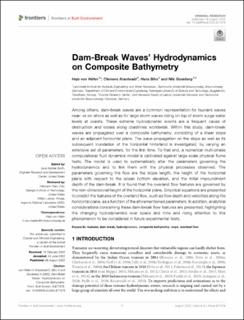| dc.contributor.author | von Häfen, Hajo | |
| dc.contributor.author | Krautwald, Clemens | |
| dc.contributor.author | Bihs, Hans | |
| dc.contributor.author | Goseberg, Nils | |
| dc.date.accessioned | 2023-03-08T08:35:13Z | |
| dc.date.available | 2023-03-08T08:35:13Z | |
| dc.date.created | 2022-10-28T15:20:56Z | |
| dc.date.issued | 2022 | |
| dc.identifier.citation | Frontiers in Built Environment. 2022, 8 . | en_US |
| dc.identifier.issn | 2297-3362 | |
| dc.identifier.uri | https://hdl.handle.net/11250/3056925 | |
| dc.description.abstract | Among others, dam-break waves are a common representation for tsunami waves near- or on-shore as well as for large storm waves riding on top of storm surge water levels at coasts. These extreme hydrodynamic events are a frequent cause of destruction and losses along coastlines worldwide. Within this study, dam-break waves are propagated over a composite bathymetry, consisting of a linear slope and an adjacent horizontal plane. The wave propagation on the slope as well as its subsequent inundation of the horizontal hinterland is investigated, by varying an extensive set of parameters, for the first time. To that end, a numerical multi-phase computational fluid dynamics model is calibrated against large-scale physical flume tests. The model is used to systematically alter the parameters governing the hydrodynamics and to link them with the physical processes observed. The parameters governing the flow are the slope length, the height of the horizontal plane with respect to the ocean bottom elevation, and the initial impoundment depth of the dam-break. It is found that the overland flow features are governed by the non-dimensional height of the horizontal plane. Empirical equations are presented to predict the features of the overland flow, such as flow depth and velocities along the horizontal plane, as a function of the aforementioned parameters. In addition, analytical considerations concerning these dam-break flow features are presented, highlighting the changing hydrodynamics over space and time and rising attention to this phenomenon to be considered in future experimental tests. | en_US |
| dc.language.iso | eng | en_US |
| dc.publisher | Frontiers Media | en_US |
| dc.rights | Navngivelse 4.0 Internasjonal | * |
| dc.rights.uri | http://creativecommons.org/licenses/by/4.0/deed.no | * |
| dc.title | Dam-Break Waves’ Hydrodynamics on Composite Bathymetry | en_US |
| dc.title.alternative | Dam-Break Waves’ Hydrodynamics on Composite Bathymetry | en_US |
| dc.type | Peer reviewed | en_US |
| dc.type | Journal article | en_US |
| dc.description.version | publishedVersion | en_US |
| dc.source.pagenumber | 21 | en_US |
| dc.source.volume | 8 | en_US |
| dc.source.journal | Frontiers in Built Environment | en_US |
| dc.identifier.doi | 10.3389/fbuil.2022.877378 | |
| dc.identifier.cristin | 2066170 | |
| cristin.ispublished | true | |
| cristin.fulltext | original | |
| cristin.qualitycode | 1 | |

